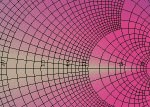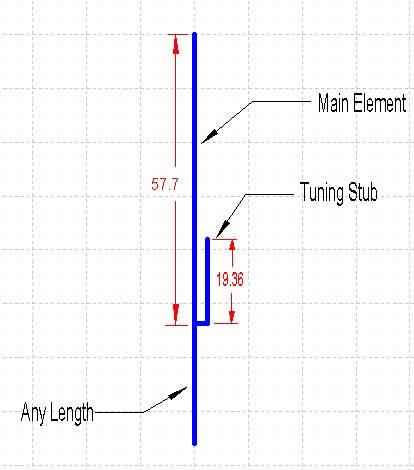 If you are looking for an inexpensive, and easy to construct antenna, the J-pole antenna is a great one! In about an hours time, and about $15 worth of materials, you can have a great performing omnidirectional j-pole antenna.
If you are looking for an inexpensive, and easy to construct antenna, the J-pole antenna is a great one! In about an hours time, and about $15 worth of materials, you can have a great performing omnidirectional j-pole antenna.
The j-pole antenna is basically an end fed half wave dipole that uses a 1/4 wave shorted matching stub as an impedance transformer. The j-pole antenna will yield slightly less than 3 DB of gain omnidirectionally.
The material I chose to build the j-pole antenna was 3/4 inch copper pipe used for plumbing. Here are the plans to build a 2 meter J-pole antenna:

The above dimensions for the J-pole are in inches. Measurements on overall length, and stub length are from the centerline of the separation pipe (horizontal) to the top of the antenna. The Connect at measurement is 2 1/4 inches from the top of the horizontal member to the point of connection. The distance between the main element of the j-pole centerline and the tuning stub centerline is 2″. I cut a length of RG-8X foam coax to a length of 67″ for the feedline, and coil up 4 turns (as small as you can get it) just below the horizontal part of the matching section. This will de-couple the feedline from the j-pole antenna, and help provide some lightning protection. Connect the center conductor of the coax to the main element, and the shield to the tuning stub of the j-pole.
In all of the above dimensions, they are to be considered starting points for constructing a j-pole. I temporarily attach the coax using 1 inch hose clamps, and adjust the coax connection first to the lowest SWR. From there, I adjust the length of the main element of the J-pole. Then I start over by re-adjusting the coax connection.
Mike does the feedline for the pvc pipe antenna inside the pipe or outside?
Hello,
It really doesn’t matter if the feedline is inside the pipe or outside. Since its easier to put it on the outside, that is how I build my J-pole antennas.
Mike, I want to make a old tv antenna into a 2 meter yagi . can it be done.
Yes it can be done. I have done it a couple of times. However there is one caveat, which is mainly a mechanical issue. Since most TV antennas are what is known as a Log-Periodic Dipole Array (LPDA) that the elements are in a Vee configuration, that would make re-building the TV antenna into a 2 meter Yagi more difficult. Sometimes you can find a LDPA whose elements are perpendicular to the antennas main boom section, those are the ones that can be rebuilt. With those its a simple matter of drilling out the rivets and placing the elements at the proper spacing. Then cut them to the proper length for 2 meters.
Old TV antennas are a good source of aluminum for making various ham radio antennas.
Good luck!
— Mike
I would like to build your antenna. However, I have a couple of questions. First let me say I come from a machinist’s background. We measure things in thousandths of an inch or less. OK, now for my questions: You give measurements as “centered” in the soldered joint if I understand your directions as written. 1) What is the CUT LENGTH of the elements when they are bottomed out into the 90 degree elbows (a positive stop). That will give an exacting measurement rather than an “eyeballed close enough” sort of length.
2) What is the dimension of the horizontal “cross over piece between the two uprights? (The cut length when bottomed into the elbow and the tee connectors)?
3) How far up on the vertical elements do I solder in the connector for the coax? (please give this dimension from the very bottom on the antenna to the point where the soldered wire is connected. Exacting measurements should give 1:1 SWR.
Thank you.
Dave
Hello,
First of all, with antennas, all measurements are just starting points. I.E. “for reference”. I have been building antennas since I was 14 years old and I can’t think of a time when cutting exactly to a formula or plan that I achieved a 1:1 SWR. If I get a 1:1.5 SWR I consider the antenna tuned.
As I state in the post “In all of the above dimensions, they are to be considered starting points” This even can vary when building several “identical” J-pole antennas.
Sorry for being vague, but with antennas its not like dealing with machinist precision. Honestly I fell like its more like voodoo magic.
Hopefully you have some sort of SWR meter or antenna analyzer.